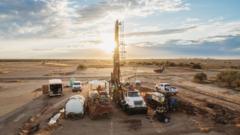Will Trump's Copper Tariffs Benefit US Mining Billionaires?

The Impact of Tariffs on Copper Imports: A Double-Edged Sword for the U.S. Economy
The recent decision to implement a 50% tax on copper imports into the United States has sparked a heated debate among industry leaders, economists, and consumers. While some, like billionaire mining entrepreneur Robert Friedland, view the tariffs as a necessary step to restore the U.S. copper industry, others express concern about the potential inflationary effects on consumer prices. This article delves into the complexities of the tariff situation, exploring its implications for the American economy, the global copper market, and future industry developments.
Understanding the Copper Tariff Landscape
On August 1, a 50% tariff on copper imports will officially come into effect in the United States. This move follows previous tariffs imposed on steel and aluminum, reflecting the administration's broader economic strategy. President Trump has argued that these tariffs are vital for national security, aiming to reduce dependency on foreign sources for essential raw materials.
Copper is a critical metal in the modern economy, used extensively in construction, renewable energy technologies, electric vehicles, and data centers. As demand continues to rise, especially in emerging markets like China and India, the pressure on U.S. copper imports has intensified. The International Energy Agency (IEA) has warned that without increased mining efforts, global copper demand will exceed supply significantly by 2035.
Industry Perspectives on the Tariff
Robert Friedland, the founder of Ivanhoe Mines and Ivanhoe Electric, supports the tariff, arguing that it will stimulate domestic copper production and ensure stable access to essential materials. His perspective is that a strong local copper industry will provide job opportunities and reduce reliance on imports from countries with unstable political climates.
However, critics like Ewa Manthey from ING Bank warn that while the tariffs may benefit U.S. mining operations, they could also lead to higher consumer prices as production costs rise. Copper is integral to various industries, and inflationary pressures could have far-reaching consequences, affecting everything from home construction to consumer electronics.
Economic Implications of Higher Copper Prices
As the tariff approaches, copper prices have surged to record highs. This increase reflects not only the impending import tax but also the heightened demand for copper in various sectors. The construction and manufacturing industries, which rely on affordable copper, may face delays and increased costs due to the rising prices.
In the context of inflation, the U.S. Federal Reserve has resisted calls to cut interest rates, focusing on controlling inflation to reach the target of 2%. The combination of rising commodity prices and tighter monetary policy could create a challenging environment for consumers and businesses alike.
The Current State of U.S. Copper Production
Historically, the United States was the world's largest producer of copper. However, this title has shifted to countries like Chile, the Democratic Republic of Congo, and Peru. Over the years, the U.S. has seen a significant decline in its refining capacity, with only three smelters remaining in operation compared to eleven in 1997. This decline has forced U.S. copper to be sent abroad for processing, while China's share of global refining capacity has increased to 44%.
A report by the Copper Development Association suggests that revitalizing domestic copper production will require investment in processing capacity. Friedland's upcoming Santa Cruz project in Arizona aims to address this need, with plans for the first new copper mine in over a decade. Expected to begin production in 2028, the project promises to deliver high-quality copper suitable for immediate use in modern technologies.
Challenges Facing U.S. Copper Mining
While the prospect of increased domestic copper production is promising, it is not without its challenges. Many companies are eager to tap into U.S. copper reserves, but they often encounter delays in obtaining permits and face legal challenges that hinder progress. This complicated regulatory environment has made it difficult for new mining projects to come online as quickly as needed.
Friedland remains optimistic, believing that Trump's focus on manufacturing jobs will drive demand for raw materials like copper. He envisions a competitive landscape where U.S. mining operations can thrive, providing essential materials for both domestic and international markets.
The Broader Economic Debate
The discussion surrounding the copper tariffs raises critical questions about the balance between national security and economic efficiency. Adam Posen, President of the Peterson Institute for International Economics, argues that the costs associated with such tariffs could outweigh the potential benefits, imposing significant burdens on consumers and businesses across the nation.
As the U.S. seeks to revitalize its copper industry, the implications for consumers, manufacturers, and the broader economy must be carefully considered. The interplay between tariffs, inflation, and domestic production will shape the landscape of the American mining sector and its role in the global economy.
Future Outlook for the Copper Industry
As we look ahead, the future of the copper industry in the United States remains uncertain. The anticipated tariffs may provide a short-term boost to domestic production, but the long-term implications are less clear. The global demand for copper is projected to continue rising, driven by advancements in technology and the push for renewable energy solutions.
With initiatives like the Green New Deal and other government plans focusing on sustainability, copper's role in facilitating the transition to a greener economy cannot be overstated. As the world shifts toward electric vehicles, solar panels, and energy-efficient infrastructure, the need for copper will only increase.
FAQs About Copper Tariffs and Their Impact
What are the immediate effects of the 50% copper tariff?
The immediate effects of the copper tariff will likely include increased prices for copper products, which could lead to higher costs for consumers and delays in construction projects. It may also incentivize domestic production and processing of copper resources.
How will the tariffs impact the construction industry?
The construction industry may face higher material costs due to increased copper prices. This could delay projects and potentially lead to higher housing prices for consumers.
Will the copper tariffs lead to more jobs in the U.S.?
Proponents of the tariffs argue that they will lead to increased domestic mining operations, potentially creating jobs in the mining and processing sectors. However, the overall impact on employment will depend on various factors, including how quickly companies can navigate regulatory challenges.
What are the long-term implications of the copper tariffs?
Long-term implications may include a revitalization of the U.S. copper mining industry, increased prices for copper products, and potential inflationary pressures on the economy. The effectiveness of the tariffs in achieving these goals will depend on market dynamics and global demand.
Conclusion: A Complex Landscape Ahead
The introduction of a 50% tax on copper imports represents a significant shift in American economic policy, with far-reaching implications for the mining industry, consumers, and the economy as a whole. As stakeholders navigate the complexities of this new landscape, the potential benefits and drawbacks must be weighed carefully. Ultimately, the success of these tariffs in achieving their intended goals will depend on how effectively the U.S. can ramp up domestic production while managing the broader economic consequences.
As the U.S. embarks on this new chapter in its copper industry, one must wonder: will these tariffs pave the way for a resurgence in domestic production, or will they hinder economic growth and innovation? #CopperTariffs #MiningIndustry #EconomicImpacts
Published: 2025-07-29 16:07:05 | Category: wales



